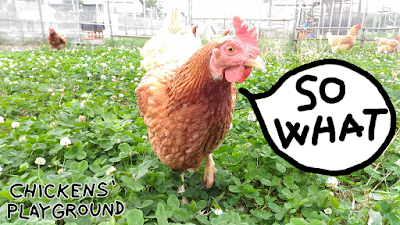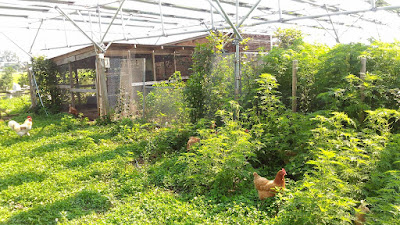Our chickens are now two years and three months old and this affects both the quantity and the quality of the eggs they lay.
 |
| Exactly. (But some people seem bothered.) |
In this post I'll explain one specific "quality" issue related to hens' age - something that most people don't know about.
When we talk eggs, we usually have in mind several indicators to tell us how fresh and/or how good quality an egg is. We look whether the shell is strong and hard to break, whether the yolk is firm and has the 'right' color (whatever that means) and whether the white is thick and upstanding.
These may look like pretty commonsense rules, but at least that part about egg white - that's only half of the story. The other half is worth knowing too, especially if you buy eggs from a small farm where chickens might live longer than commercial layers on large, industrial style farms.
Egg white
We usually consider it an i
ndicator of freshness.
That's what egg industry tells us and what we, consumers, believe. And in general it's true - a firm, thick egg white is usually a sign of fresh egg.
Except,
it’s not always true.
That’s what I learned from our chickens, who are now far beyond the working age of laying hens in the "modern" egg industry, where hens are normally disposed of at 17-18 months of age. Ours are 27 months old and about to announce their retirement, but at the moment they still lay eggs, which we still sell, although only to the last few most understanding customers who care about the chickens as much as about the eggs.
So here's the thing about the egg white, the fancy word for which is
albumen.
 |
There are two types of albumen in every egg: thick and thin
In this article we're talking about thick albumen. |
Albumen is typically thick and upstanding when the egg is freshly laid, but becomes thinner as days pass, especially if you store eggs in a warm and humid place, or in a place where temperature frequently changes.
Albumen height is considered such an important indicator that in the egg industry and egg science, it is measured with a tripod micrometer and used as a basis for calculating Haugh unit - a ubiquitous measure of egg freshness since it was
invented in 1937.
Less known is the fact that
as hens grow older, their eggs' albumen height naturally decreases. It is a normal change - a result of hens' reproduction organs aging.
In case of our flock, the differences are also quite individual – some hens still lay eggs with firm egg whites, others not so. All hens are exactly the same age, live in the same environment, eat the same diet and are all healthy – so the difference can only be attributed to individual genetic makeup.
Also, our hens are not really "old" yet. With a natural life span of 8-10 years, a two-years-and-three-months-old hen (our flock) is not
that much older than a one-and-a-half-year-old hen (slaughter age of laying hens).
As for those eggs with lower albumen height, everything else is just fine - the egg looks fine, the shell is strong and the yolk is firm. It’s just the egg white getting flatter. Despite it being a natural consequence of the hen's age and genes, this egg, even though it's fresh, would be considered by ordinary consumer as old and of lower quality.
But
if a healthy hen lays a pretty,
perfectly edible egg whose only fault is thinner egg white, is that really a
quality issue, or is it just a man-made fussiness?
I wondered.
If it is a
real quality issue, low albumen height surely must be a sign of some other profound defect. It
can't be just the fact that the egg spreads too much on a frying pan for your sunny side up, right? Two hypothesis come to mind.
Hypothesis 1: Maybe low albumen height is a sign of
fewer nutrients. Like, less vitamins or minerals in the egg?
I checked it out and the answer is: Nope, it seems that
albumen height has nothing to do with nutritional content. This conclusion is based (besides common sense) on the fact that I simply could not find any evidence - no data, no scientific studies, no observations or even a discussion - about the relationship between albumen height (or Haugh unit) and nutritional value of eggs. Given how much and how thoroughly eggs have been studied and tested and researched around the world for decades, the fact that there is no information at all on this topic seems like a reliable proof that there is no such relationship. The closest I could find was
this study of partridge eggs, which found that "[t]here is no effect of the storage time on the mineral content of the egg."
[1]
Hypothesis 2: Maybe low albumen height means that you
can’t whip it into good foam? That would be real functional deficiency for both processing industry and individual consumers who like baking.
So I checked it out and the answer is: Nope,
lower albumen height does not cause lower whipping volume. In fact, it causes higher whipping volume, as practical experience and
this study shows. So you get
more whipping foam out of
less firm albumen.
[2]
In other words,
we have two egg quality criteria - albumen height and whipping volume - that contradict each other. SO SMART.
So now we know that low albumen height is not a sign of some deeper quality problem. It's rather a human-invented aesthetic function of fried eggs with about as much substance to it as saying that a big apple is of higher quality than a small apple, because ... because.
 |
| Seriously? |
But at least it is an indicator of freshness, right?
Well,
no. I already mentioned that albumen height decreases with hens' age, and that there are individual differences between hens. This is not just personal observation, it's what research, such as the
study mentioned above, shows: although it is true that albumen height decreases with storage, it is also a heritable trait and is biased by the age and strain of hen, therefore it is not a reliable indicator of freshness. By the way, a better indicator of freshness would be
albumen pH, which "is determined almost entirely by storage time and may be more useful than albumen height for measuring egg quality."
[2]
To sum it up, when an egg has thin egg white, it can be either because the egg is old, or because the hen is "old" or because the hen inherited the trait from her parents.
Most people don't know this because they don't keep backyard flocks anymore and the egg industry has only been telling us the first part of the story - that albumen height decreases with storage.
What does it mean for hens?
For hens it means that they are killed too soon.
Of course, both quality and quantity of eggs goes down by the time hens are 17-months old. By then, a flock of 100 hens would lay about 65 - 70 eggs a day, as compared to more than 90 eggs/day during peak lay period. That's the quantity part. As for quality, the major issue with older hens is thinner egg white explained above.
Whether you interpret the 65-70 eggs as too many or too few as a threshold for culling the whole flock - that's a matter of opinion. Speaking for myself, killing the entire flock of healthy hens when they could still produce every day 65 - 70 perfectly okay eggs, whose only fault would be slightly thinner egg white, sounds like a terrible disregard for animal life. You certainly wouldn't kill all chickens at that point if they were your own backyard flock.
The problem with "modern" farming is that the value of an animal is inversely proportionate to the number of animals, in other words, the more animals you have, the less important an individual animal is. Large farms with tens of thousands of chickens simply get them on the truck and send them to the slaughter house. This is much different on our "farm" with less than two dozens of chickens. We marvel every day how cute they are (although the rooster can be an as*hole) and then we kill them
ourselves. I know it's unavoidable, but frankly, killing a chicken is not exactly a pleasant thing to do, especially not for the chicken. We want to reduce the frequency of slaughter sessions to minimum and so far we were able to do exactly that thanks to our customers who stayed with us and kept buying the eggs despite chickens' age.
Of course, our customers are special and I know I can't expect the same compassion and generosity from everyone.
But I still imagine how nice it would be if more people in the world were able to, both metaphorically and literally, see the hen behind the egg, as our customers can, and decide what is more important to them - a thick egg white that only young hens can produce, or a hen that had happy and (relatively) long life that she deserves, even if, towards the end, the egg white is not quite as thick as the egg industry has been telling us it should be.
 |
| Wanna know my opinion? |
Oh, and I almost forgot. I guess you'd like to see what our hens' eggs actually look like. Here are four randomly chosen eggs from today morning. These eggs were laid by 2-years-and-3-months-old hens.
Actually, they look quite okay, don't they?
*****************************
External links
[1]
Günhan S., Kirikçi K. 2017
Effects of different storage time on hatching results and some egg quality characteristics of rock partridge (A. graeca) (management and production). [
Abstract]
[2]
Silversides F. G., Budgell K. 2004
The Relationships Among Measures of Egg Albumen Height, pH, and Whipping Volume. [
Full text]























































